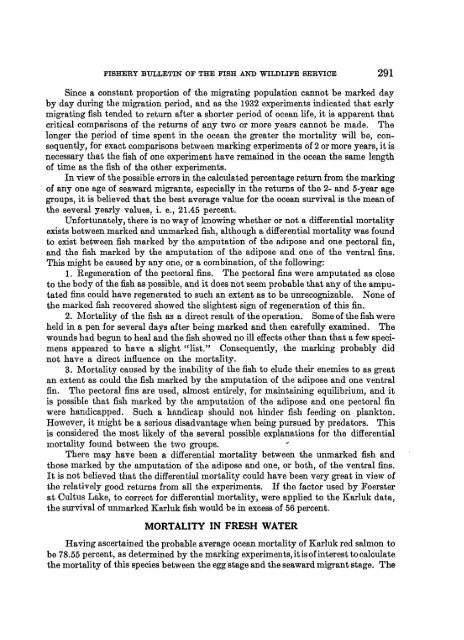Fishery bulletin of the Fish and Wildlife Service - NOAA
Fishery bulletin of the Fish and Wildlife Service - NOAA
Fishery bulletin of the Fish and Wildlife Service - NOAA
Create successful ePaper yourself
Turn your PDF publications into a flip-book with our unique Google optimized e-Paper software.
FISHERY BULLETIN OF THE FISH AND WILDLIFE SERVICE 291<br />
Since a constant proportion <strong>of</strong> <strong>the</strong> migrating population cannot be marked day<br />
by day during <strong>the</strong> migration period, <strong>and</strong> as <strong>the</strong> 1932 experiments indicated that early<br />
migrating fish tended to return after a shorter period <strong>of</strong> ocean life, it is apparent that<br />
critical comparisons <strong>of</strong> <strong>the</strong> returns <strong>of</strong> any two or more years cannot be made. The<br />
longer <strong>the</strong> period <strong>of</strong> time spent in <strong>the</strong> ocean <strong>the</strong> greater <strong>the</strong> mortality will be, consequently,<br />
for exact comparisons between marking experiments <strong>of</strong> 2 or more years, it is<br />
necessary that <strong>the</strong> fish <strong>of</strong> one experiment have remained in <strong>the</strong> ocean <strong>the</strong> same length<br />
<strong>of</strong> time as <strong>the</strong> fish <strong>of</strong> <strong>the</strong> o<strong>the</strong>r experiments.<br />
In view <strong>of</strong> <strong>the</strong> possible errors in <strong>the</strong> calculated percentage return from <strong>the</strong> marking<br />
<strong>of</strong> any one age <strong>of</strong> seaward migrants, especially in <strong>the</strong> returns <strong>of</strong> <strong>the</strong> 2- <strong>and</strong> 5-year age<br />
groups, it is believed that <strong>the</strong> best average value for <strong>the</strong> ocean survival is <strong>the</strong> mean <strong>of</strong><br />
<strong>the</strong> several yearly values, i. e., 21.45 percent.<br />
Unfortunately, <strong>the</strong>re is no way <strong>of</strong> knowing whe<strong>the</strong>r or not a differential mortality<br />
exists between marked <strong>and</strong> unmarked fish, although a differential mortality was found<br />
to exist between fish marked by <strong>the</strong> amputation <strong>of</strong> <strong>the</strong> adipose <strong>and</strong> one pectoral fin,<br />
<strong>and</strong> <strong>the</strong> fish marked by <strong>the</strong> amputation <strong>of</strong> <strong>the</strong> adipose <strong>and</strong> one <strong>of</strong> <strong>the</strong> ventral fins.<br />
This might be caused by any one, or a combination, <strong>of</strong> <strong>the</strong> following:<br />
1. Kegeneration <strong>of</strong> <strong>the</strong> pectoral fins. The pectoral fins were amputated as close<br />
to <strong>the</strong> body <strong>of</strong> <strong>the</strong> fish as possible, <strong>and</strong> it does not seem probable that any <strong>of</strong> <strong>the</strong> amputated<br />
fins could have regenerated to such an extent as to be unrecognizable. None <strong>of</strong><br />
<strong>the</strong> marked fish recovered showed <strong>the</strong> slightest sign <strong>of</strong> regeneration <strong>of</strong> this fin.<br />
2. Mortality <strong>of</strong> <strong>the</strong> fish as a direct result <strong>of</strong> <strong>the</strong> operation. Some <strong>of</strong> <strong>the</strong> fish were<br />
held in a pen for several days after being marked <strong>and</strong> <strong>the</strong>n carefully examined. The<br />
wounds had begun to heal <strong>and</strong> <strong>the</strong> fish showed no ill effects o<strong>the</strong>r than that a few specimens<br />
appeared to have a slight "list." Consequently, <strong>the</strong> marking probably did<br />
not have a direct influence on <strong>the</strong> mortality.<br />
3. Mortality caused by <strong>the</strong> inability <strong>of</strong> <strong>the</strong> fish to elude <strong>the</strong>ir enemies to as great<br />
an extent as could <strong>the</strong> fish marked by <strong>the</strong> amputation <strong>of</strong> <strong>the</strong> adipose <strong>and</strong> one ventral<br />
fin. The pectoral fins are used, almost entirely, for maintaining equilibrium, <strong>and</strong> it<br />
is possible that fish marked by <strong>the</strong> amputation <strong>of</strong> <strong>the</strong> adipose <strong>and</strong> one pectoral fin<br />
were h<strong>and</strong>icapped. Such a h<strong>and</strong>icap should not hinder fish feeding on plankton.<br />
However, it might be a serious disadvantage when being pursued by predators. This<br />
is considered <strong>the</strong> most likely <strong>of</strong> <strong>the</strong> several possible explanations for <strong>the</strong> differential<br />
mortality found between <strong>the</strong> two groups.<br />
There may have been a differential mortality between <strong>the</strong> unmarked fish <strong>and</strong><br />
those marked by <strong>the</strong> amputation <strong>of</strong> <strong>the</strong> adipose <strong>and</strong> one, or both, <strong>of</strong> <strong>the</strong> ventral fins.<br />
It is not believed that <strong>the</strong> differential mortality could have been very great in view <strong>of</strong><br />
<strong>the</strong> relatively good returns from all <strong>the</strong> experiments. If <strong>the</strong> factor used by Foerster<br />
at Cultus Lake, to correct for differential mortality, were applied to <strong>the</strong> Karluk data,<br />
<strong>the</strong> survival <strong>of</strong> unmarked Karluk fish would be in excess <strong>of</strong> 56 percent.<br />
MORTALITY IN FRESH WATER<br />
Having ascertained <strong>the</strong> probable average ocean mortality <strong>of</strong> Karluk red salmon to<br />
be 78.55 percent, as determined by <strong>the</strong> marking experiments, it is <strong>of</strong> interest to calculate<br />
<strong>the</strong> mortality <strong>of</strong> this species between <strong>the</strong> egg stage <strong>and</strong> <strong>the</strong> seaward migrant stage. The

















